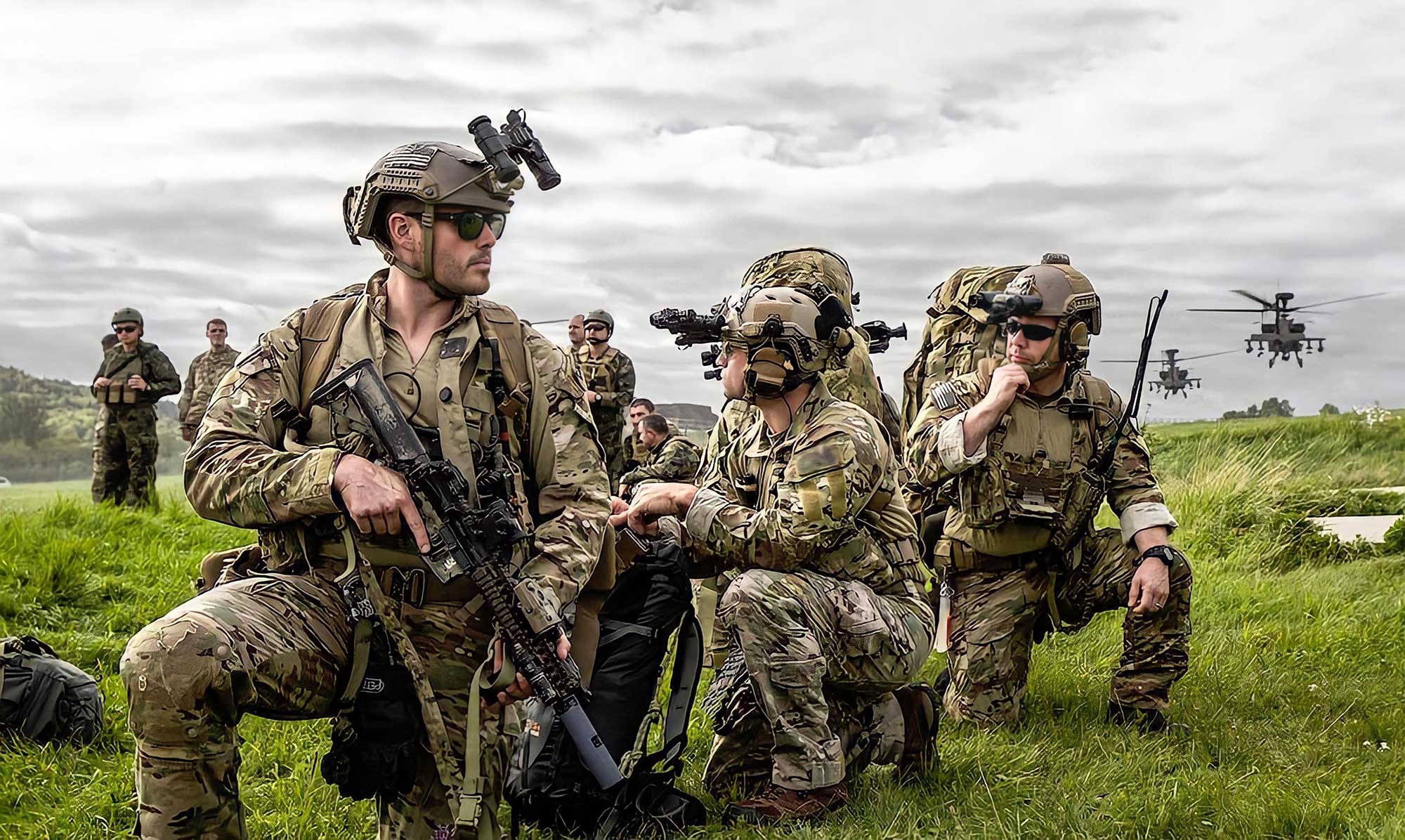DOWNLOAD
The term Irregular Warfare (IW) is pervasive in the modern Department of Defense (DoD) lexicon, but it has a lengthy history. In Cold War-era military publications, IW was not defined but its meaning was generally fixed. After 9/11, it gained popularity and formal definitions, but its meaning became more ambiguous, largely because of its connection to other concepts, especially in the special operations forces (SOF) arena.1 This was evident when the U.S. shifted from Counter-Violent Extremist Operations (C-VEO) to Great Power Competition (GPC) in recent years. This brief history of the term IW begins during the Korean War (1950-1953).
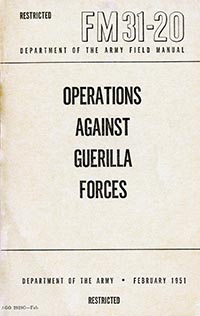
In February 1951, the Army published Field Manual (FM) 31-20: Operations Against Guerrilla Forces. It relayed that the “term ‘guerilla warfare’ is used loosely to describe all kinds of irregular warfare.”2 Though undefined, IW was synonymous with guerrilla warfare. FM 31-21: Organization and Conduct of Guerilla Warfare (October 1951) defined guerrillas as an “irregular force, organized on a military basis, supported chiefly by sympathetic elements of the population, and operating against established … authority.”3 IW was linked primarily to Communist-inspired insurgencies, with connotations of being a duplicitous form of warfare.

In the 1960s, terms such as Unconventional Warfare (UW), Counterinsurgency (COIN), and Special Warfare gained traction. Though seldom used by comparison, IW remained tied to Communist revolutionary doctrine. The U.S. Army Special Warfare Center’s “Readings in Counter-Guerrilla Operations” (1961) described IW as central to Mao Zedong’s philosophy.4 In 1961, the Army published FM 31-15: Operations Against Irregular Forces, in which “irregular forces” were synonymous with Communist adversaries who were to be operated against and destroyed, an idea also found in FM 31-21: Guerrilla Warfare and Special Forces Operations (1961).5 In 1962, scholar Raymond L. Garthoff argued that IW was “the essence of Marxist-Leninist theory [and] the base of Communist strategy.”6 Also in 1962, Hugh H. Gardner published Guerrilla and Counterguerrilla Warfare in Greece, 1941-1945 (through the Office of the Chief of Military History). According to Gardner, Communist Greek partisans “employed irregular methods and their behavior cannot be judged by conventional standards.”7 While IW remained minimally or not defined, it was widely understood as the non-conventional approach used mainly by Communist guerrilla forces.
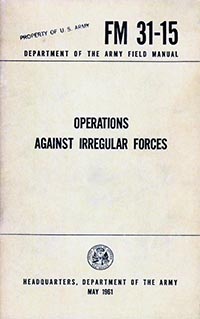
Comparatively few sources claimed that the U.S. might use IW. A 1961 Office of the Secretary of Defense report advocated additional research into IW to “improve our allies’ ability to resist Communist aggression” and “provide the U.S. with increased understanding of and general capability in irregular warfare.”8 This idea was also in Joseph P. Kutger’s 1963 article, “Irregular Warfare in Transition.” Further, Kutger offered a definition of IW: “[it] comprises all those types of warfare alien to the conventional warfare … It is usually employed against an adversary as a means of minimizing his relative advantages, either in numerical strength or in the technology of his weaponry.”9 This article did not relegate IW to just enemy forces.
After Vietnam, IW’s meaning seemingly changed little, though it remained sporadically used and not defined. For example, FM 90-8: Counterguerrilla Operations (1986) made no mention of IW.10 However, things changed after the 9/11 terrorist attacks. U.S. military operations in Afghanistan and Iraq led to a spike in popularity for such terms as UW, COIN, Foreign Internal Defense (FID), stability operations (SO), nation-building, and full-spectrum operations. The term IW resurfaced and gained new prominence within the Army and DoD lexicon.

In 2005, the U.S. Joint Forces Command (USJFCOM) issued a briefing called “Historic Analysis of Lessons Learned from Modern Irregular Warfare.” It explained that IW lacked a definition but was related to such terms as COIN, UW, FID, and terrorism. It also clarified that IW was something that the U.S. might do and not just counter.11 Months later, the U.S. Special Operations Command (USSOCOM) and the Assistant Secretary of Defense for Special Operations and Low-Intensity Conflict held a workshop to draft a definition of IW, compile a list of IW activities, and build the basis for a “consensus on what [IW] is and a roadmap to incorporate IW in DoD strategic thinking.” It linked IW with UW, COIN, FID, SO, Civil-Military Operations (CMO), Psychological Operations, terrorism/counter-terrorism (CT), Information Operations, intelligence/counterintelligence, Internal Defense and Development, and even transnational crime. IW’s proposed definition was: “a warfighting philosophy aimed at achieving strategic objectives by applying or countering an approach to war that seeks to erode an adversary’s power and will, primarily through the use of indirect, non-traditional means.”12 As the DoD worked toward a definition, IW’s historic link to enemy insurgencies was eroding.
In 2006, the Deputy Secretary of Defense approved a working definition of IW: “A form of warfare that has as its objective the credibility and/or the legitimacy of … political authority with the goal of undermining or supporting that authority. [IW] favors indirect approaches, though it may employ the full range of … capabilities to seek asymmetric advantages [to] erode an adversary’s power, influence, and will.” IW’s key elements were: (a) undermining or supporting an existing political authority; (b) mostly “indirect approaches”; and (c) eroding the power, influence, and will of adversaries. This definition paved the way for future refinements.
The same year, the USMC and USSOCOM collaborated on the latest “Multi-Service Concept for Irregular Warfare,” which argued that IW aims to maintain or undermine “the legitimacy of a political authority [through] indirect approaches and nonconventional means to defeat an enemy by subversion, attrition, or exhaustion rather than direct military confrontation.” It employs “the full range of military and non-military capabilities to gain asymmetric advantages that erode an adversary’s power, influence and will until he is neutralized or defeated. IW is the preferred approach of insurgents, terrorists, and others who lack substantial conventional warfare capability as well as of nation-states who must mask their actions or whose national troops use IW in fighting irregular warriors.” This product argued that the key to U.S. victory “in the global long war in the years ahead is development of a … multi-agency capacity for irregular warfare,” one of the clearest endorsements of the need to embrace IW so far.13
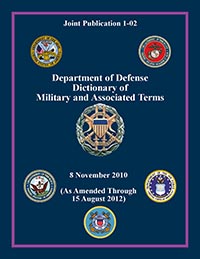
Within a decade after 9/11, IW had a formal definition. DoD Directive 3000.07 (2008) and Joint Publication (JP) 1-02: Department of Defense Dictionary of Military and Associated Terms (2010) defined IW as: “A violent struggle among state and non-state actors for legitimacy and influence over the relevant population(s).”14 This definition had three noteworthy aspects. First, it hearkened back to the earlier meaning by describing IW as a “violent struggle.” Second, it included state and non-state actors, meaning that virtually anyone could conduct IW. Finally, it broadened potential targets to “relevant population(s).” In other words, IW is a violent struggle between potentially anyone for legitimacy and influence over others. IW now had a definition, but its meaning was so broad as to be arguably useless.
The 2017 change to JP 1: Doctrine for the Armed Forces of the United States (2013) upheld the definition in JP 1-02 and continued to contrast IW with traditional warfare. However, it introduced a slight contradiction when it stated that in IW, “a less powerful adversary seeks to disrupt or negate the … capabilities and advantages of a more powerful military force,” but also that “most U.S. operations since the [9/11] terrorist attacks have been irregular.”15 By this description, the U.S. was the “less powerful adversary seek[ing] to disrupt or negate the … capabilities and advantages of a more powerful military force,” which was not true in Afghanistan or Iraq. This was indicative of the challenge of stabilizing IW’s meaning after 9/11.
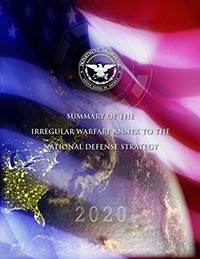
By the 2010s, the U.S. had entered a new era of strategic competition. The 2018 National Defense Strategy (NDS) signaled the pivot away from C-VEO to Great (or Global) Power Competition with other major powers, namely China and Russia. The NDS led to the Irregular Warfare Annex to the National Defense Strategy in February 2019, followed by the more widely publicized Summary of the Irregular Warfare Annex to the National Defense Strategy. These explained IW as “a struggle among state and non-state actors to influence populations and affect legitimacy” (dropping the qualifier “violent struggle”). According to the summary, “IW favors indirect and asymmetric approaches, though it may employ the full range of military and other capabilities” against an adversary. The list of IW-related activities had broadened further to include such activities as UW, FID, CT, COIN, CMO, stabilization, military information support operations (MISO), cyber operations, countering threat networks (CTN), and counter-threat finance (CTF).16 IW’s entanglement with other terms continued to complicate things (adding to the potential confusion with Information Warfare, also shortened to IW). IW had reached peak importance, but its meaning was broad, vague, and fluid; it could mean anything (mostly non-conventional) done by anyone to influence, delegitimize, or defeat anyone else.

In 2021, the J-7, Joint Staff, published its “Irregular Warfare Mission Analysis,” the “first comprehensive review of [IW] since 2007. The global strategic environment has significantly shifted … and the [DoD’s concept] of what [IW] is and how to employ it must shift also.” Contrary to older characterizations of IW, this report argued that IW “is as strategically important as traditional warfare.” It conceded that “IW is … complex, messy, and ambiguous,” and “does not lend itself to clean, neat, concise, or precise definition.” Though it did not define IW, it reiterated its ties with CT, UW, FID, COIN, and SO. Ironically, it called this association “confusing and counterproductive” before listing even more IW-related activities, such as UW, FID, CT, COIN, CTN, CTF, CMO, stability activities, MISO, and Civil Affairs, among others.17 This mission analysis did little to clarify IW’s meaning, but it was a major step toward reimaging IW in GPC and initiating what has been described as a DoD-wide “mindset shift” toward IW.


